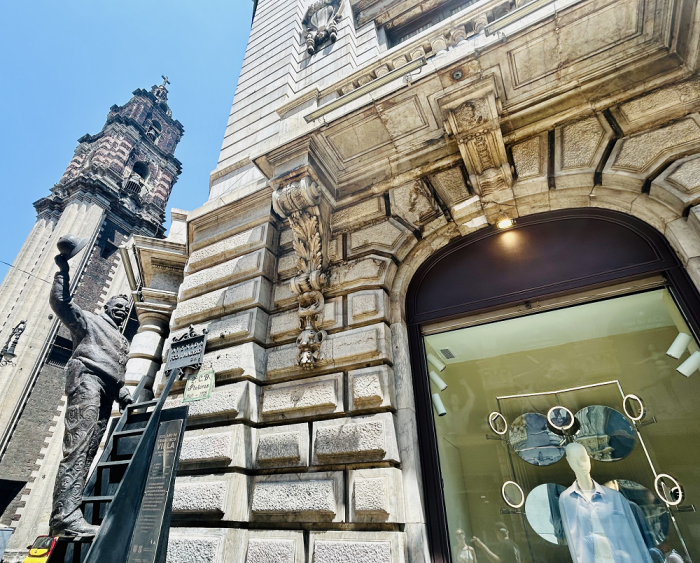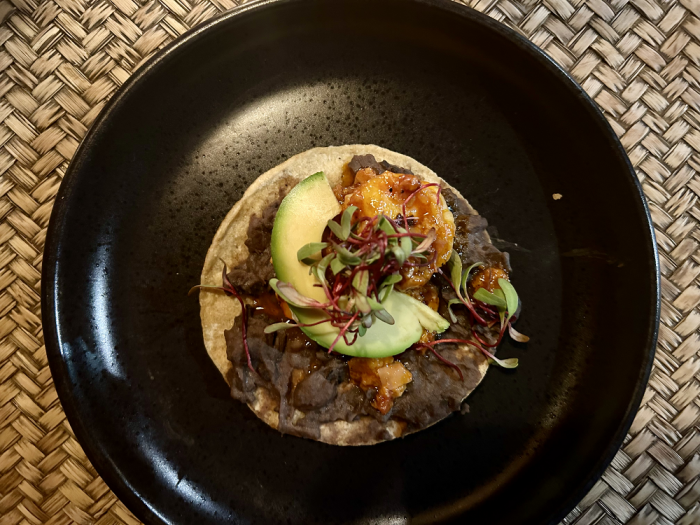Cynthia Dial
Confession: While I have traversed the globe, visited all seven continents and countless capital cities, I had not experienced Mexico City . . . until recently. So, join me on my discovery of Mexico’s largest city, the Western Hemisphere’s most populous and a metropolis recognized as one of the world’s top 10 in size. At first glance, this urban utopia of 22.5 million was overwhelming in size. Yet when explored, Mexico City surprisingly conveyed a small-town vibe when within one of its innumerable neighborhoods.

Cynthia Dial
“Buenas tardes,” we were greeted as the wheels of our Aeromexico’s flight hit the tarmac. From the air, the landscape appeared dusted with color – the lilac hue of the seasonally blooming jacaranda (typically February to May) amid splashes of vivid pink, yellow and turquoise house exteriors. Imaginative murals appeared like surround-sound, even on ever-busy roadways. Spurred by its energizing appearance, initial excitement was generated, too, by the unknown.

Cynthia Dial
I found a city defined by impressive stats – four UNESCO World Heritage Sites, six Aztec temples, 31 archeological spots, 100 five-star hotels, 180 museums, 478 galleries and a collection of all different, all one-of-a-kind local communities. This was also a city characterized by a dichotomy of attributes – from quaint cobbled streets and on-the-road food stalls to multi-lane roundabouts and a gastronomy scene anchored by almost 58,000 eateries (calculation: if one were to dine at a different restaurant for each meal on every day for more than a half-century, additional eating spots would remain).
Overwhelmed? Understandable. My advice: Follow the guidance of the legendary proverb, “How do you eat an elephant? One bite at a time.” Then, design an itinerary of a few “must-see” districts. The key is to become acquainted with one region at a time – on your own timetable.

Cynthia Dial
Neighborhood by Neighborhood
My choices – each projecting its own charismatic character – helped me uncover a portion, albeit little more than a fraction, of Mexico City’s many layers. From experience, suggested guidelines would be to balance your program with old and new, seek curated culture as well as on-the-move encounters and investigate via your palate.
Centro Histórico – At its nucleus was Plaza de la Constitución – the city’s massive main square. Surrounded by history dating back as far as the Aztec Empire, a 360-degree rotation at its center revealed the Metropolitan Cathedral, National Palace (the official residence of Mexico’s president), Federal District buildings and the excavated discovery of Templo Mayor (a UNESCO World Heritage Site), alongside a collection of table-top merchants, indigenous performers and religious artifact retailers.
An additional one-mile-long stroll along nearby pedestrian-only Calle Madero – a street that showcased trademark shopping, America-inspired skyscrapers and the commemorative sculpture of Pancho Villa – further immersed me into Ciudad de México.

Cynthia Dial
Coyoacán – If there were only one reason to visit this locality, it would be Casa Azul (Blue House), the working residence of noted artists Frida Kahlo and Diego Rivera – now a museum. Named for its cobalt blue coloring, this peek behind the curtain of the legends’ tumultuous lives far rewarded the effort made to acquire a must-get-in-advance ticket.
But the community offered much more – beckoning green space, Frida “everything” in tribute to the area’s most beloved resident and the nearby artisans’ market (bring cash in small bills as many do not accept credit cards).

Cynthia Dial
Xochimilco – Another burst of color and accompanying fun was found along Mexico City’s historic network of canals meandering throughout this prolific flower/vegetable-producing community. Representing the last vestiges of yesteryear’s vast water transport system, it was an impressive creation of the Aztecs – today a UNESCO World Cultural Heritage Site. Here, flamboyantly painted gondola-like boats (called trajineras) commandeered by gondoliers (known as trajineros) negotiated mile after mile of floating gardens. On-the-water food, drink and craft vendors, alongside trajineras of floating mariachis provided whatever boaters desired. Depending on the day, it could be a party-boat-like atmosphere or a peaceful, hours-long silent float (weekends were liveliest; early Monday mornings the most serene).
I enjoyed an insider’s encounter on one of the “farms” with lunch prepared by Rosa – local landowner/guide. Cooked with produce handpicked by my group, our meal was served beneath a covered awning on the family’s outdoor picnic area. “Provecho” (enjoy your meal), she announced and the plein air feast began.

Cynthia Dial
Roma – “Food trends start here, and I want to share Mexico through its cooking,” said Alma with Sabores Mexico Food Tours in the introduction of our guided, five-hour culinary journey of Colonia Roma. As the gastronomic gathering spot for all the country’s flavors, Mexico City has been deemed the “best place to taste Mexico.”

Cynthia Dial
Discovering the neighborhood by walking it, I learned its 61 murals were painted to proclaim “Roma is back” after its near destruction by the 1985 earthquake. And I became enchanted with its Art Deco and French Art Nouveau architecture, as much as its food, art and cultural scenes.

Cynthia Dial
Through the exploration of six food-and-beverage stops, I was introduced to this country, city and borough’s food culture. Located in the charming center courtyard of a 1900s home, Chef Marco Margain’s Broka Bistrot replicated last century’s romantic relationship with dining. Casual in style, yet offering first-class flavor, was Tres Galeones which served an assortment of taqueria-style options – many reflective of owner/chef Rodrigo Malvido’s affinity for seafood. Café Deraíz was known for its exceptional tamales. Cooking from a collection of more than 400 tamale recipes, owners Pola Carballo and her brother Mardonio Carballo have created a significant following for this modest café’s cuisine.

Cynthia Dial
The goal of Chef Diana López del Ríos, owner of Mux, was “to take customers on a culinary expedition.” Specializing in mole – a rich, complex sauce – López del Ríos shared that “everything was made with much love.” Along the same sentiment, Francisco, the owner of one of Roma’s newest eateries, Kaaj, explained: “In Mexico, food is how we say, ‘I love you.’” He additionally advised the proper way to drink mescal – “in small sips, like little kisses.” The evening ended at Café Barajas, a coffee bar known for its more than 20 ways to prepare the beverage. My drink, Café Olla – a Mexican-ground coffee enhanced with cinnamon and raw dark sugar – was the evening’s faultless finale.

Cynthia Dial
One Last Look
To get an overview of this 570-square-mile city, I additionally traveled along Paseo de la Reforma, the broad boulevard that dissected it. Comparable to some of the world’s most famous avenues – from Paris’ Champs-Élysées to Russia’s Nevsky Prospekt in St. Petersburg – the vast thoroughfare was dotted with towering office complexes, globally-recognized hotel brands and revered monuments, most notably the Angel of Independence. This trek along Reforma embodied “the Mexico City” I initially envisioned. And coupled with my visit’s nods to the neighborhoods, it validated its well-earned reputation – “the city that has it all.”
Tips
Relax and always plan to return. Mexico City could never be captured in one visit.
For ease and savings (30-50{6036d1da27a1d3b5aa2f18d9e8df5a860af5f1dff3a0fe6451ed182baa94fd4e}), fly from Tijuana to Mexico City, utilizing the San Diego-connected dedicated border crossing, CBX (). Open 24/7, it’s a simple walk across the 390-foot enclosed pedestrian sky bridge from the U.S. into the Mexican airport.
While a variety of airlines operate the Tijuana-Mexico City route, Aeromexico serves up the greatest number of daily flights along this route, with all operations – domestic and international – increasing in 2024.
For more, visit .




